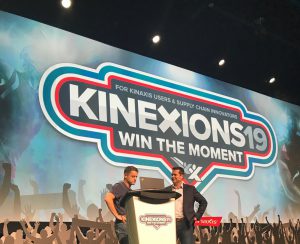Recently, over 500 supply chain professionals descended upon Orlando, Florida for a few days of awesome sessions, training courses and networking. It was Kinexions ‘19! Being a fairly new member of Kinaxis, this was my first Kinexions and I was excited to see what it was all about. With attendees from all over the world and across multiple industries, the type of discussions underway were diverse. It was great to hear so much buzz around the automotive industry and how original equipment manufacturers (OEMs) and suppliers alike leverage Kinaxis technology to “Win the Moment!” Here are my top three auto industry takeaways.
1. It's time to get a handle on your demand
Demand accuracy is a challenge most any supply chain professional laments over. In the automotive industry, it’s incredibly difficult to wrap your arms around it, especially with new considerations like more vehicle personalization and a shortened product life cycle entering the fray. In his session, Kinaxis Global Enterprise Architect Luiz Solia discussed how an automotive leader strikes a balance between build-to-stock (BTS) and build-to-order (BTO). The right mix varies wildly from manufacturer to manufacturer, but by utilizing concurrent planning and technologies like machine learning and artificial intelligence, automotive leaders can truly understand their customer. Armed with that info, they can determine how many finished goods should be available at a dealership at any given time, or how many can be produced on-demand by consumer order. Advances within the Kinaxis RapidResponse® demand sensing capabilities are improving accuracy as well. Kinaxis Business Consulting Team Lead, Bill Riordan noted that a very common demand challenge in automotive surrounds the use of incentives. With demand sensing in RapidResponse, organizations can account for both OEM incentives and dealer incentives, getting a more accurate picture of demand and accounting for promotions overall. This level of knowledge can also give parts suppliers a better estimate of the parts that will be needed at a given time, helping to provide greater visibility into lead times.
#demandsensing in RapidResponse #automotiveindustry can account for both dealer incentives and consumer incentives to better understand demand. #kinexions19 (@MandaSchweitzer) October 16, 2019
2. If you aren't already planning for tariffs, you're behind
Tariffs were a hot topic spanning industries at Kinexions this year. The uncertainty of these changing tariffs is causing chaos for organizations and putting mounting pressure on supply chain teams. However, multiple Kinaxis customers mentioned their use of RapidResponse to manage this constantly fluctuating terrain. Kristen LeBaron of Lippert Components noted her team is utilizing scenarios to understand the impacts of various tariff changes on their end-to-end network. A semi-conductor manufacturer presented a session on how they are partnering with Kinaxis on their tariff management solution. They are shifting strategies to decrease the number of tariffs they'll incur from the outset. They're also considering duty drawbacks in their overall approach. The company noted they were facing a 3200% increase in potential tariffs before utilizing RapidResponse to better manage this challenge. There is definitely more to come on this topic from Kinaxis, so stay tuned!
@kinaxis Solia shares that it’s the most disruptive time in the #automotive #supplychain in 100 years. #Kinexions19 (@MandaSchweitzer) October 15, 2019
3. Manufacturers have to balance competing customer demands
As anyone in the automotive industry knows, the times are changing! With autonomous driving, connected cars, ride sharing, and continued growth of electric, the next age of innovation is upon us. But all of these innovations add more complexity to supply chain operations. Solia noted that as the preference for electric vehicles grows globally, the demands placed on automotive supply chains increase. For example, regulatory bodies are placing stricter emissions caps on manufacturers. The growth in demand for electric vehicles also impacts suppliers and the overall bill of material for each model. A typical standard engine has around 1,000 parts, whereas an electric engine has a mere 200. The need to be more sustainable is also competing with the growth of vehicle option personalizations in the industry, which shortens product life cycle dramatically. Manufacturers are being asked to provide a more complex product with a much shorter shelf-life while simultaneously working towards sustainability.
Utilizing concurrent planning for your digital strategy is key in a changing landscape
How are auto leaders accommodating these diverse demands? Solia emphasized the need for a global view to best utilize resources across the enterprise. Coupling that with more advanced cognitive analytics, better supplier collaboration and data harmonization, the industry can be ready to face this changing landscape in order to best serve their customers. Check out more about how Kinaxis is helping auto leaders navigate these new business challenges in our new on-demand webinar.





Leave a Reply